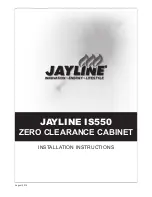
14
250-3692 (11/2000) DVi32 Gas Insert
Figure
TABLE 1
MINIMUM HEIGHT
ROOF PITCH
FEET
METERS
FLAT TO 7/12
1
0.3
OVER 7/12 TO 8/12
1.5
0.46
OVER 8/12 TO 9/12
2
0.61
OVER 9/12 TO 10/12
2.5
0.76
OVER 10/12 TO 11/12
3.25
0.99
OVER 11/12 TO 12/12
4
1.22
OVER 12/12 TO 14/12
5
1.52
OVER 14/12 TO 16/12
6
1.83
OVER 16/12 TO 18/12
7
2.13
OVER 18/12 TO 20/12
7.5
2.29
OVER 20/12 TO 21/12
8
2.44
The height of the Vent Cap must meet the minimum
building code requirements described above.
H
DIMENSION “H”
OBTAINED
FROM TABLE 1
VERTICAL TERMINATIONS (cont.)
USING GS SERIES PIPE (cont.)
Step 6.
Slip the flashing over the pipe section(s)
protruding through the roof. Secure the base
of the flashing to the roof with roofing nails.
Insure the roofing material overlaps the top
edge of the flashing (Figure 4). Verify that you
have at least the minimum clearance to
combustibles at the roofline.
Step 7.
Continue to assemble pipe sections and seal
with silicone until the height of the vent cap
(H) (Figure 5) meets the minimum building
code requirements described in Table 1 (Figure
5), and outlined in the current CANGA-Bl49
Installation Codes (in Canada), the National
Fuel Gas Code NFPA 54/ANSI Z223.1 (in
USA), or local codes. Note that for steep roof
pitches, the vent height must be increased. In
high wind conditions nearby trees, adjoining
rooflines, steep pitched roofs, and other similar
factors can result in either poor draft or down
drafting. In these cases increasing the vent
height may solve this problem. If in doubt,
follow the 2-10-3 rule as shown below:
FIG. 5
FIG. 4
Shingles overlap top edge
of flashing.
f i r e - p a r t s . c o m






































